Web exclusive: Check out some of the stories we’re talking about in this story here.
We’ve published a lot of stories over the past 25 years. And a lot of those have been pretty memorable: stories that have helped nudge the college into making sure they’re following their own rules (hello, smoking areas being moved), and stories that have made us laugh maybe a bit more than they should have (hey, editing a story about one of our writers tripping out in the middle of the day in a local high-school field takes the edge off).
There have been countless others: investigating allegations of corruption in a national student organization, exploring modern masculinity (and facing the resulting backlash), and trying to get to the bottom of why Camosun fired their president when she said her contract was terminated for no reason are a few that come to mind.
Here are five other stories that are particularly memorable, along with some thoughts from those who wrote them.
Evaluation eruption
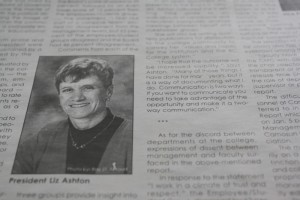 In 2001, a student approached our writer Mathieu Powell, saying Camosun students needed to know the details of an in-camera meeting where the performance of then-president Liz Ashton was being evaluated. After discussing it with the managing editor at the time, they felt they could put together what they saw as a fair, balanced article, protecting the anonymity of the student who had shown Powell the confidential documents containing the evaluation, which wasn’t all roses (the words “heavy-handed” and “patronizing” jump off the page).
In 2001, a student approached our writer Mathieu Powell, saying Camosun students needed to know the details of an in-camera meeting where the performance of then-president Liz Ashton was being evaluated. After discussing it with the managing editor at the time, they felt they could put together what they saw as a fair, balanced article, protecting the anonymity of the student who had shown Powell the confidential documents containing the evaluation, which wasn’t all roses (the words “heavy-handed” and “patronizing” jump off the page).
So we published the story, in our April 2, 2001 issue.
“The next day, all hell broke loose,” says Powell.
Powell says that the then-chair of Camosun’s board of governors threatened to have Powell expelled if he didn’t agree to meet him, return the documents, and reveal his source.
“There were two principles I knew I needed to adhere to,” says Powell. “I knew I needed to remain cordial and respectful no matter how angry I was, and I knew I needed to protect my source. I felt then and still feel today these are two foundational ethics of investigative journalism.”
Powell, who stresses how much it means to him that then-managing editor Barbara Risto supported him through the whole process, met with the chair but didn’t reveal his source and made it clear he had never owned copies of the documents in question. He says Camosun students were made aware of the situation, and the board and Nexus “found a way to resolve our differences.”
Not the best and brightest comment
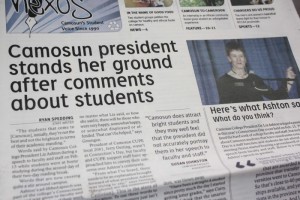 Camosun students are “not the best and not the brightest in terms of their academic training”: these are the words that slipped out of Camosun’s then-president Liz Ashton’s mouth at a Camosun event she was speaking at back in 2008, probably seconds before she had that sinking feeling we’ve all had where you realize, oops! That was no good!
Camosun students are “not the best and not the brightest in terms of their academic training”: these are the words that slipped out of Camosun’s then-president Liz Ashton’s mouth at a Camosun event she was speaking at back in 2008, probably seconds before she had that sinking feeling we’ve all had where you realize, oops! That was no good!
“[Then-managing editor] Jason [Schreurs] heard about the quote from a union member who was at a meeting where there were no students,” says Ryan Spedding, who wrote about it for the paper. “The union member gave us a DVD which had the speech where Liz said that quote. I remember four or five of us gathered around a little monitor in the Nexus office to watch it.”
So we reported on it, as the student newspaper should, in Spedding’s story “Camosun president stands her ground after comments about students” in our March 5, 2008 issue.
In the story, Ashton says “Camosun students are not coming out of high school as the highest qualified academic students. That’s a reality; it’s not me in any way putting students down.” (Students we talked to for the issue disagreed and also took issue with Ashton’s stereotyping and generalizing, as did students who wrote letters to us after reading the story.)
“I recall when I interviewed Liz about the quote,” Spedding says, “her main defence was no student was supposed to hear it.”
Indeed, in the story, Ashton stands behind the fact that this was a speech not intended for students.
“I was talking with passion and commitment, I wasn’t talking from notes,” Ashton said in the story, going on to say that the negative reaction from Camosun students, both current and former, was not justified at all. “…it was not a speech to students and they weren’t present there,” she said. “All they got is a transcription of something I said.”
Allegations of abuse
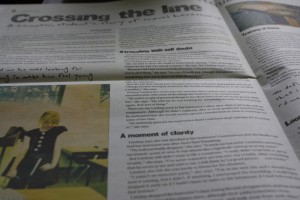 Our October 7, 2009 issue featured the cover story “Crossing the line,” which told an Interurban student’s story of being allegedly sexually harassed by her Camosun instructor. The story, written by Keltie Larter, is a good example of how the paper has never shied away from covering issues that impact Camosun students, even if it means putting Camosun College in the hot seat.
Our October 7, 2009 issue featured the cover story “Crossing the line,” which told an Interurban student’s story of being allegedly sexually harassed by her Camosun instructor. The story, written by Keltie Larter, is a good example of how the paper has never shied away from covering issues that impact Camosun students, even if it means putting Camosun College in the hot seat.
In the story, the student, whose name we did not publish, talks about how her instructor, whose name we also did not publish, had allegedly insinuated that she would receive special consideration in the class if she gave him some of her time… and maybe more than her time.
“He definitely gave me the impression that I could have slept with him if I’d wanted to,” the student said in the story, also noting that “He told me he was looking for something to make him feel young again.”
“The woman in this article was a friend of mine,” says Larter. “She told me the story over beers at her girlfriend’s house. When I asked her if I could write an article about her experience, she was nervous but eventually agreed. I thought it was an important story to tell for two reasons: first, I wanted to shed light on the fact that a teacher at Camosun did this so that other women on campus would know to be wary. And, secondly, I wrote the story because my friend was too scared of dealing with the consequences to report the teacher who did this to her, and I wanted to scare the shit out of him. I hope he saw it and had more than a few sleepless nights. And I hope it kept him, and any other teachers who may have considered behaving the same way, from ever doing something like that again.”
Nuns have more… oh, forget it
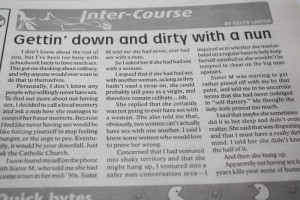 In our March 31, 2010 paper, Larter, writing as our sex columnist, decided to take the issue’s humour theme to a new high… or low, depending on how you look at it: Larter decided to call up a nun to ask if she’d ever had sex with another woman.
In our March 31, 2010 paper, Larter, writing as our sex columnist, decided to take the issue’s humour theme to a new high… or low, depending on how you look at it: Larter decided to call up a nun to ask if she’d ever had sex with another woman.
“Wow,” says Larter about this story making its way to the list at hand. “Well, to be honest, it’s too bad this article got so much more attention than any of my other funnier, more eloquent, more interesting ones. But controversy tends to draw a crowd, doesn’t it?”
After the column ran (right around the Easter weekend, to boot), not only did the Nexus office get a surprise appearance from an offended pastor (you can’t make this stuff up), but Larter got some much more hostile feedback online.
“Predictably, some of the Catholics who read the article freaked the fuck out and started posting all kinds of nasty comments on the online version,” she says. “They called me a whore and a demon and a bully, and I think some of them tried to get me in trouble with the college. To be honest, it kind of freaked me out.”
The silence remains
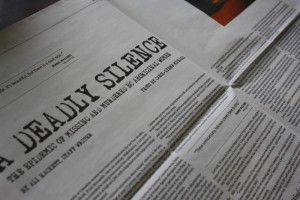 This one is bittersweet: it’s one of the most rewarding features I’ve had the pleasure of editing, and our writer Ali Hackett won an award for her amazing work on it, but the subject matter is certainly nothing to feel joy over. Hackett’s cover story in our September 7, 2011 issue, “A deadly silence,” tackled Vancouver’s missing aboriginal women epidemic with a power and poignancy, and attention to journalistic detail, that proved we can hit just as hard as any other news outlet. (Hackett also did an excellent follow-up feature for our April 4, 2012 issue, called “Gone but not forgotten,” which included a detailed timeline of events.)
This one is bittersweet: it’s one of the most rewarding features I’ve had the pleasure of editing, and our writer Ali Hackett won an award for her amazing work on it, but the subject matter is certainly nothing to feel joy over. Hackett’s cover story in our September 7, 2011 issue, “A deadly silence,” tackled Vancouver’s missing aboriginal women epidemic with a power and poignancy, and attention to journalistic detail, that proved we can hit just as hard as any other news outlet. (Hackett also did an excellent follow-up feature for our April 4, 2012 issue, called “Gone but not forgotten,” which included a detailed timeline of events.)
“As a writer I feel proud of my work looking back on it, and I’m grateful for the personal growth,” says Hackett today, “but as a person I still feel complete devastation thinking about the murdered and missing women, both past and future.”
It was Hackett’s first feature for us, and she says the writing process was an eye-opener for her.
“When I first started research for my article, I could not believe what I was seeing: biased media coverage and systemic bigotry in the justice system in a majority white society with a history of colonialism had allowed this horrific situation to persist virtually unchecked for decades,” she says.
The story hangs on our wall; it reminds me every day what student media is capable of.
What’s your favourite Nexus memory? Let us know at editor@nexusnewspaper.com!
Read about the history and the impact of the paper here.

